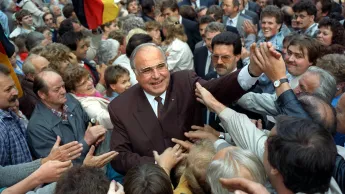Landmark elections after reunification
- 2023-12-11
- Miriam Hoffmeyer
- Comment

A wall in East and West Germany divided Germany from 1961 until 1989. While a parliamentary democracy was established in the Western Federal Republic of Germany, socialism under a one-party dictatorship was in place in the East, the German Democratic Republic (GDR). The Wall fell on 9 November 1989, paving the way for the reunification of the whole of Germany after years of division. The GDR ultimately acceded to the Federal Republic of Germany on 3 October 1990 and reunification became a reality. Almost two months after reunification, on 2 December 1990, Germans in the East and West elected the 12th German Bundestag. How the unification process would proceed was the focal point of this first free election of an all-German parliament since 1932.
Hopes were high, yet the social and economic challenges were even greater: East German companies had a massive technological deficit to overcome given over 40 years of planned socialist economy. Their trading relations with Eastern Europe had largely collapsed because East German products, which now had to be paid for in D-Mark, the currency of the Federal Republic, did not match the quality of Western products. East German towns and cities were in need of renovation, since the extent of pollution caused by the coal and chemical industries was alarmingly high.
Promises and reality: the era of Helmut Kohl
Helmut Kohl (CDU), Chancellor of the Federal Republic of Germany, had played a decisive role in bringing about reunification and exuded optimism: the five eastern federal states of Mecklenburg-Vorpommern, Brandenburg, Saxony-Anhalt, Saxony and Thuringia, which had previously been part of the GDR, would soon be transformed into ‘prospering landscapes’, said Kohl. This formulation became a common saying that was popular with satirists, in particular once the difficulties of the transformation in East Germany became increasingly clear. During the 1990 election campaign, the Chancellor promised the West Germans ‘internal unity’ without disadvantages and rejected tax increases. The leading Social Democratic candidate, Saarland Minister President Oskar Lafontaine, conversely considered tax increases to be unavoidable. Lafontaine used his election campaign speeches to warn about the proliferating costs of unity and a higher national debt.
Unique elections: East and West in political transformation
In 1990 there were around 60 million Germans who were eligible to vote; around a quarter of them lived in East Germany. The citizens of West Berlin were permitted to vote for the Bundestag for the first time. This had not previously been possible due to the city’s special status. The division into an East German and a West German electoral area was unique. It was intended to ensure equal opportunities for smaller parties in East Germany that had not (yet) merged with West German parties. The Federal Election Act stipulates that parties may only enter the Bundestag if they receive at least five per cent of the vote. The special regulation in 1990 meant that it was sufficient for a party to pass the necessary so-called five per cent hurdle in only one of the two electoral areas. It enabled the Party of Democratic Socialism (PDS), which emerged from the East German ruling party the SED and received eleven per cent of the vote in the East, to enter the Bundestag. The West German Greens failed at the five per cent hurdle: barely anyone was interested in their election campaign issue – phasing out nuclear power – so soon after reunification. The ‘list grouping’ of the East German Greens and the former GDR civil rights movement ‘Bündnis 90’, on the other hand, achieved six per cent in the East German electoral area and thus entered the Bundestag.
Historical victory: CDU/CSU and FDP dominate the election
All of the forecasts predicted a clear victory for the Christian Democrat-Liberal governing coalition under Helmut Kohl, the ‘Chancellor of unity’. And so it came to pass: the CDU/CSU achieved 43.8 per cent nationwide. Their smaller coalition partner the FDP, led by the very popular Foreign Minister Hans-Dietrich Genscher, gained votes and reached eleven per cent. The second major party, the SPD, plummeted to 33.5 per cent, its worst result since 1957. Lafontaine’s pessimism didn’t go down well with the electorate.
Symbolic location: the inaugural session in Berlin
Despite the fact that the Federal Republic of Germany was still governed from Bonn at the time, the inaugural session of the first all-German Bundestag took place in the Reichstag building in Berlin on 20 December 1990 for symbolic reasons. The Bundestag once again elected Helmut Kohl as Chancellor on 17 January 1991. His government declaration promised equal living conditions in East and West, and a rapid ‘spiritual, cultural, economic and social unity within Germany’.
These weren’t achieved as soon as expected: the financial strains caused by ‘Aufbau Ost’ (a programme for reconstruction of the East) proved to be so great that a new tax soon had to be introduced, the ‘solidarity surcharge’. The decline of the East German economy was dramatic: the majority of former state-owned companies were liquidated and some 1.6 million jobs were lost. Extensive mass unemployment in the 1990s resulted in considerable social dissatisfaction in East Germany. West Germans frequently assumed the management positions in business and administration, which meant that many former GDR citizens felt as if they were ‘second class Germans’. Only gradually did the differences between East and West Germany successively diminish. The issue of ‘internal unity’ is nevertheless an issue that still concerns Germans today.
